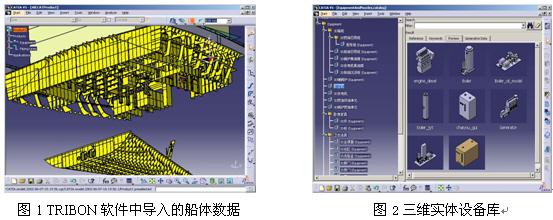As we all know, CATIA [1] software has been widely used in a number of high-end technology manufacturing industries such as aerospace and automotive, and has achieved very successful results. The introduction of CATIA into the shipbuilding industry is a direct reference or indirect reference to CATIA's advanced and mature technologies in the aerospace, aerospace, automotive and other manufacturing industries. These technologies have very unique references to the design of conventional marine engineering platforms, especially for aircraft carriers, warships, luxury cruise ships, drilling platforms, etc. [1, 2]. CATIA enables visualization of the vessel's three-dimensional design. Its basic functions cover all aspects of ship design, throughout the analysis, design, construction, and maintenance of the entire ship's product life cycle. The modules of CATIA software are powerful, flexible in working mode, rich in design and simple in use, and are used in the three-dimensional design of the ship's engine room. The basic functions can be summarized as the following six aspects: 1. Design and introduction of hull structural models; 2. “Manufacturing†all kinds of real 3D equipment, component series solid modeling; 3. Three-dimensional physical arrangement of the cabin; 4. Two-dimensional schematic design and three-dimensional arrangement and component positioning of equipment and pipelines; 5. Output of various statistical summary reports, processing forms, layout drawings, and installation drawings; 6. Electronic sample ship. The operating platform of each module of the CATIA software seamlessly integrates basic general mechanical CAD functions with dedicated ship design CAD functions. In actual ship design, the user can switch the working mode in real time according to his specific design project (ie hull structure, surface modeling, piping design, electrical cable design, duct design, knowledge engineering, ergonomics, parts). And assembly design, mechanical drawing, mechanism simulation, mold design, sheet metal design, physical quantity calculation, interference inspection, strength analysis and other working modes), flexible and maneuver to adopt various design methods and methods in the working mode environment, thus, users It can maximize the various knowledge engineering resources of CATIA software. At the same time, it can also construct its own "personalized" working mode, set various toolbars on its platform, select appropriate icons, supplement corresponding instructions, and thus be creative. Complete your own design work. 1. 1 Design and introduction of hull structure model The hull structure is the basis for the design of the ship's cabin. The CATIA software provides the software for the actual application of various CAD/CAM/CAE software in the shipbuilding industry (eg TRIBON / NAPA / Maxsurf / Fastship / AUTOCAD, etc.) Dedicated or standard interface. These dedicated or standard interfaces provide a convenient tool for the shipbuilding industry's existing CAD/CAM/CAE application software to easily and flexibly import data. This paper directly reads the structure data of *.dxf format in TRIBON shipbuilding integration software, and transforms and generates the hull structure model in CATIA software, as shown in Figure 1. 1.2 “Manufacturing†Real-world modeling of various types of real 3D equipment and parts Using CATIA software advanced 3D solid, surface, wireframe modeling technology and powerful 2D, 3D (front and back) parameterization functions, starting from points, lines and surfaces, constructing 3D solids, can be "manufactured" series Various types of marine equipment (see Figure 2: mainframe, auxiliary boiler, fuel pump, oil collection cylinder, cabinet, generator, fuel supply unit, etc. in the dictionary file), base, cabinet (dairy cabinet, sedimentation) Cabinets, etc., components, valve parts (stop valves, quick-closing valves, safety valves, etc.), accessories (all types of flanges, gaskets, joints, etc.), instruments (level gauges, flow meters, etc.), pipe brackets, Cabin equipment (office furniture, file cabinets, sanitary ware, daily household appliances, etc.), armored doors and windows, corridor railings, etc. After these three-dimensional solid modeling work is completed, it is divided into categories, which constitute a dictionary file (ie library file). It is convenient to call these “spare†files in real time for the three-dimensional arrangement of the ship cabins under construction. At the same time, in the CATIA software, the parameterized database construction facilitates the change of the volume size and interface position of the same type of equipment. Next page DQOK is a professional manufacturer and supplier of kitchen faucets. Our company mainly produces brass/304 Stainless Steel bathroom Kitchen Sink faucets with high cost performance and high quality. We also provide OEM products and services for you. Kitchen Faucet,Kitchen Taps,Brass Kitchen Faucet,Stainless-Steel Sink Faucet Heshan Dingquan Sanitary Ware Industry Co., Ltd , https://www.dqoksanitary.com
2 CATIA for ship 3D design 
Research on 3D design method of ship cabin based on CATIA (Figure)
1 Introduction